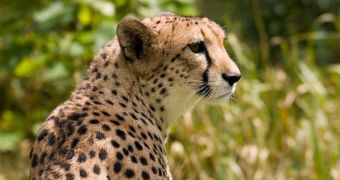Since Ancient times, people have been fascinated with the way these large cats run, and especially with the speed that they can reach, of up to 112 to 120 kilometers/hour (70 and 75 mph) over short distances of about 460 meters (1,500 feet). What exactly makes the cheetah run so fast has been a subject of controversy among specialists. While some attribute the trait to powerful muscles, others say that the shape of the spine is the most important factor. A new study in the UK is currently looking at the animals, in a bid to determine which claim is right.
In an experiment set up by a team of researchers from the Royal Veterinary College (RVC), captive cheetahs follow a piece of chicken on a string, traveling at high speed, and, in their chase, run directly over a track of sensor boards, which can detect minute variations in the way their weight is distributed on their feet, the BBC News informs. Their pass is also monitored with a number of high-speed cameras, able to record up to 1,000 frames per second, and mounted at various angles in regards to the animal's running direction. Their purpose is to offer a 3D view of the cheetah, as it moves away.
“The cheetah is fascinating because it can run 50% faster than any of the other animals we are familiar with, so in terms of understanding what limits how fast you can run, the cheetah is a wonderful animal to study,” the Head of the RVC Structure and Motion Laboratory, Professor Alan Wilson, told the news agency. Captive North African cheetahs from the ZSL Whipsnade Zoo are used in this study.
“We use two cameras on each side of the enclosure so we can see the cheetah from both sides. When a cheetah gallops, it does different things with either side of its body – it has an asymmetric gait. The plates [in the ground] are like sophisticated weighing scales that are able to measure all the forces going through their legs,” RVC PhD student Penny Hudson added. She also said that the results obtained from these measurements would be compared with those obtained in earlier studies, conducted on greyhounds. These dogs can also reach impressive speeds, of up to 60 km/h (40 miles per hour).
In humans, whose top speed reaches about 37km/h (23mph), it's known that muscle strength prevents them from going any faster. A similar reasoning is valid for the greyhounds as well. The animals cannot swing their legs fast enough so as to increase their top speed. But, in the case of the cheetah, the reasons for its speed or its limits are not known exactly, and only theories exist at this point. “We really don't know what it is about cheetahs that make them run so fast – it might be their flexible spines, or it might be their shoulder blades, it could be that they stretch their legs a bit more, but hopefully the data will unravel some of those mysteries,” Hudson concluded.

 14 DAY TRIAL //
14 DAY TRIAL //